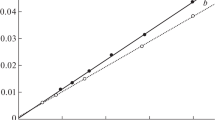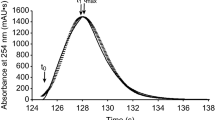Summary
The paper describes by simple experiments in a pragmatical way by easy rules of thumbs gradient optimization. Besides selection of the stationary phase and initial and final conditions the two other important variables are program time and eluent flow rate. It is demonstrated, that when the product of both, the gradient volume, is kept constant, the solutes are always eluted with the same eluent composition at column outlet. At constant gradient volume, peak broadening depends on flow rate and on the eluent properties (viscosity) at which the solutes elute, and on the time the solutes spend in the column. Because peak broadening increases with increasing gradient volume, the peak capacity in gradient elution shows an optimum at gradient volumes around 15 empty column volumes (program times 45 to 60 min at flow rates of 1 ml/min with standard columns).
Gradient elution can also be used for fast evaluation of optimum eluent composition for isocratic analysis. This procedure requires a calibration of the equipment for determination of eluent composition at column outlet. The sample is chromatographed in a standard gradient run of 10 to 15 empty column volumes. The eluent composition at which the solute of interest elutes during the gradient is used for isocratic analysis, where the k' value of this solute will then be around 2.
Similar content being viewed by others
References
G. Liteanu, S. Gocan, Gradient Elution Chromatography, Halsted Press, New York (1974).
L. R. Snyder, J. W. Dolan, J. R. Gant, J. Chromatogr.165, 1 (1979).
J. W. Dolan, J. R. Gant, L. R. Snyder, J. Chromatogr.165, 31 (1979).
L. R. Snyder, in “High Performance Liquid Chromatography”, Vol. 1,Cs. Horváth Ed., Academic Press, New York (1980).
P. Jandera, J. Churacek, Gradient Elution in column liquid chromatography. Elsevier, Amsterdam (1985).
P. J. Schoenmakers, H. A. H. Billiet, L. De Galan, J. Chromatogr.205, 13 (1981).
L. R. Snyder, M. A. Stadalius, M. A. Quarry, Anal. Chem.55, 1412A (1983).
H. Engelhardt, H. Elgass, J. Chromatogr.158, 249 (1978).
H. Engelhardt, High Performance Liquid Chromatography, Springer, New York, Heidelberg (1979).
H. Engelhardt, B. Dreyer, H. Schmidt, Chromatographia16, 11 (1982).
L. R. Snyder, Principles of Adsorption Chromatography, Dekker, New York (1968).
H. Engelhardt, H. Elgass, in High Performance Liquid Chromatography, Vol. 2,Cs. Horváth Ed., Academic Press, New York (1981).
W. E. Harries, H. W. Habgood, Programmed Temperature Gas Chromatography, Wiley, New York (1966).
J. J. Kirkland, Analyst99, 859 (1974).
H. Engelhardt, M. Aufsatz, Ann. Univ. Saravensis15, 55 (1980).
Author information
Authors and Affiliations
Additional information
Part of Ph. D. Thesis H. Elgass, Saarbrücken, 1978, present address Hewlett-Packard, Waldbronn, FRG. In part presented at Eastern Analytical Symposium, New York, 1982.
Rights and permissions
About this article
Cite this article
Engelhardt, H., Elgass, H. The gradient volume principle for fast evaluation of optimum conditions for isocratic analysis. Chromatographia 22, 31–39 (1986). https://doi.org/10.1007/BF02257293
Received:
Revised:
Accepted:
Issue Date:
DOI: https://doi.org/10.1007/BF02257293




